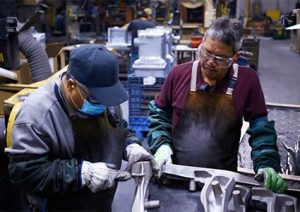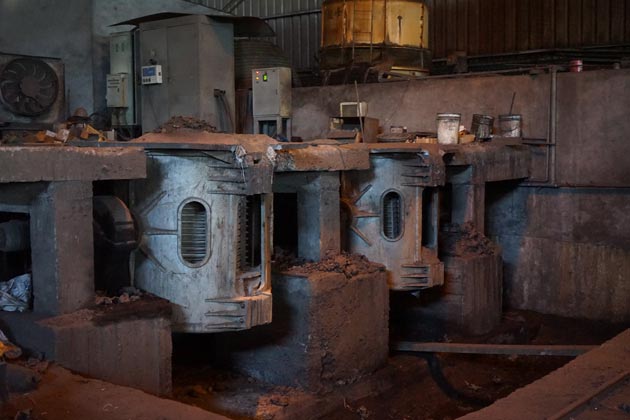A guide to Aluminum Foundry Wisconsin in industrial casting
Wiki Article
Exactly How Aluminum Foundry Adds To Advancements in Aerospace Design
Aluminum shops are important to innovations in aerospace design. They produce light-weight, high-strength parts that are important for contemporary aircraft. With advanced casting methods, these factories produce intricate geometries that enhance structural honesty. Furthermore, the development of superior Aluminum alloys supports the sector's emphasis on fuel efficiency and sustainability. Difficulties continue to be in the production procedure. Understanding these elements reveals the extensive effect of Aluminum on aeronautics's future.The Importance of Lightweight Materials in Aerospace Layout
As the aerospace industry proceeds to advance, the importance of lightweight products comes to be increasingly obvious. The need for performance and sustainability drives engineers to prioritize using materials that decrease general weight without compromising structural stability. Lightweight products, especially Aluminum, play an important role in improving gas performance, boosting payload capacity, and enhancing the total performance of airplane.Additionally, the combination of these products allows for ingenious styles, allowing makers to produce more wind resistant forms that can stand up to severe conditions. The decrease in weight not only decreases operational costs yet also adds to a lowered environmental impact, aligning with worldwide initiatives towards sustainability in aviation.
Advanced Casting Techniques in Aluminum Foundries
Advanced spreading techniques in Aluminum shops play an essential role in aerospace engineering by making it possible for the manufacturing of accurate and lightweight components. Developments in mold layout and accuracy casting processes are vital in achieving ideal performance and architectural integrity. Furthermore, the development of light-weight alloys boosts the total efficiency and performance of aerospace applications.Cutting-edge Mold Layout
Ingenious mold style plays an important role in the effectiveness and effectiveness of Aluminum foundries, specifically within the aerospace market. By leveraging innovative materials and methods, modern molds can be engineered to withstand high temperature levels and stress, ensuring peak efficiency throughout the spreading process. These styles often include complex geometries that enable the production of light-weight yet structurally sound components, vital for aerospace applications. Furthermore, using computer-aided design (CAD) software application assists in exact modeling, enabling foundries to improve and mimic mold layouts before physical production starts. This not just boosts the high quality of actors parts but also minimizes waste and preparation, resulting in significant cost financial savings. On the whole, cutting-edge mold style is a foundation of progression in Aluminum Foundry technology for aerospace engineering.Accuracy Casting Processes
The efficiency of innovative mold layouts seamlessly incorporates with precision casting procedures, which are crucial for generating premium Aluminum elements in aerospace engineering. These processes, including sand casting, die casting, and investment spreading, ensure the creation of complicated geometries with tight tolerances. Advanced techniques like vacuum cleaner spreading and pressure pass away casting boost the honesty and surface area coating of the end products. Accuracy spreading minimizes product waste while making the most of the mechanical homes of Aluminum, crucial for aerospace applications. Additionally, utilizing real-time monitoring and progressed simulation tools during the casting procedure enables instant modifications, causing improved top quality control. Jointly, these precision casting procedures setting Aluminum factories at the forefront of aerospace innovation, supporting the industry's need for dependability and performance.Light-weight Alloy Advancement
As aerospace engineers seek to boost fuel efficiency and performance, light-weight alloy advancement becomes a necessary focus in Aluminum shops. These factories utilize innovative casting strategies to produce alloys that give remarkable strength-to-weight proportions. Developments in alloy structure, including the unification of components like lithium and magnesium, enable the manufacturing of materials that stand up to severe problems while reducing total aircraft weight. Strategies such as die spreading and investment spreading promote the precision manufacturing of complicated forms, which are essential for aerospace applications. Furthermore, recurring research study intends to optimize these alloys for boosted mechanical residential or commercial properties and raised longevity. By focusing on light-weight alloy growth, Aluminum shops significantly add to the evolution of aerospace design, leading the way for extra sustainable and efficient aircraft designs.
Enhancing Architectural Honesty Via Aluminum Elements
Aluminum components provide considerable advantages in improving structural integrity within aerospace engineering. Their lightweight nature adds to general effectiveness while keeping stamina, which is necessary for airplane performance. Additionally, the tension resistance buildings of Aluminum aid assure the durability and reliability of aerospace structures under different operational conditions.
Lightweight Product Benefits
While traditional products commonly compromise weight for stamina, utilizing Aluminum elements in aerospace design offers significant benefits in structural integrity. Aluminum's light-weight nature adds to total design efficiency, enabling more structured aircraft that eat less gas, consequently boosting sustainability. The material's excellent strength-to-weight proportion warranties that elements preserve sturdiness without adding unneeded mass. This quality fosters enhanced performance and dexterity in flight, along with maximized payload abilities. In addition, Aluminum's resistance to corrosion extends the lifespan of aerospace structures, minimizing maintenance prices and improving security. index As makers progressively take on Aluminum alloys, the aerospace market experiences a transformative change towards more effective and reliable engineering solutions that prioritize both efficiency and ecological duty.Stress And Anxiety Resistance Residences
Although numerous materials possess special homes, Aluminum's remarkable stress and anxiety resistance attracts attention as an important consider improving the architectural honesty of aerospace elements. This resistance plays a critical role in guaranteeing that aircraft can stand up to different operational tensions, including tiredness, impact, and ecological conditions. Aluminum alloys, especially crafted for aerospace applications, show high tensile toughness while keeping light-weight characteristics, enabling engineers to develop a lot more effective structures - Aluminum Foundry. Furthermore, the ability of Aluminum to endure cyclic loading without significant deformation adds to the long life and dependability of aerospace elements. As advancements proceed in Aluminum Foundry strategies, the growth of stress-resistant Aluminum parts promises additional improvements in efficiency, security, and efficiency throughout the aerospace market, solidifying Aluminum's function as a recommended product in modern-day engineeringGas Efficiency Improvements Driven by Aluminum Innovations
As the aerospace industry looks for to improve gas performance, ingenious uses Aluminum have actually emerged as a necessary service. Aluminum's light-weight nature significantly decreases aircraft weight, allowing for lower fuel usage during trip. This decrease in weight is vital, as also little declines can cause substantial enhancements in overall fuel economic climate.Advanced Aluminum alloys, designed for improved toughness and durability, allow producers to create components that preserve structural honesty while reducing mass - Aluminum Foundry. In addition, the integration of Aluminum in airframes and engine elements helps with boosted aerodynamics, adding to minimized drag and raised efficiency
The adoption of Aluminum in aerospace not only meets the need for fuel-efficient style yet likewise straightens with governing pressures for reduced exhausts. As these innovations remain to progress, they play a substantial role in setting new criteria for fuel efficiency, making sure that the aerospace sector can satisfy expanding environmental and economic difficulties.

The Duty of Aluminum in Sustainable Aviation Practices
The increasing focus on sustainable air travel methods has positioned Aluminum as an essential product in the pursuit for greener aircraft layout. Known for its lightweight homes, Aluminum significantly minimizes aircraft weight, causing lower fuel usage and discharges. Its recyclability better enhances its sustainability account, as Aluminum can be reused indefinitely without loss of quality. This characteristic supports a round economic situation within the air travel field, lessening waste and resource exhaustion.Innovations in Aluminum alloys have improved their stamina and corrosion resistance, allowing for longer solution life and reduced upkeep requirements. These developments facilitate the advancement of much more reliable aircraft structures, adding to general sustainability initiatives. Additionally, Aluminum's thermal conductivity plays an important duty in energy-efficient styles, enhancing systems such as heat exchangers. Jointly, these characteristics emphasize Aluminum's pivotal function beforehand sustainable air travel, straightening with global efforts targeted at reducing the ecological impact of flight.
Obstacles Faced by Aluminum Foundries in Aerospace Production
While Aluminum shops play an essential function in aerospace manufacturing, they deal with substantial challenges that can impact manufacturing effectiveness and top quality. One advice significant challenge is the strict quality assurance requirements called for in the aerospace sector. Any kind of defect can jeopardize safety and security and efficiency, requiring rigorous evaluation processes that prolong production timelines. Furthermore, factories commonly contend with fluctuating resources prices, which can affect rates and earnings. The intricacy of Aluminum alloys used in aerospace applications further complicates the manufacturing process, as accurate solutions are crucial for achieving preferred mechanical residential or commercial properties. Experienced labor scarcities prevent the ability to maintain high-grade manufacturing levels. Ultimately, ecological regulations enforce limitations on emissions and waste monitoring, calling for factories to invest in lasting techniques, which can be cost-prohibitive. These elements collectively develop a landscape where Aluminum foundries must continually adapt to fulfill the progressing needs of aerospace production while guaranteeing safety and Learn More Here security and conformity.Future Trends in Aluminum Applications for Aerospace Design
With innovations in innovation and enhancing needs for effectiveness, the future of Aluminum applications in aerospace engineering is poised for significant makeover. The integration of cutting-edge Aluminum alloys and composites is expected to boost strength-to-weight ratios, leading to even more fuel-efficient aircraft styles. On top of that, advancements in additive manufacturing strategies will certainly enable the manufacturing of complicated Aluminum frameworks that were formerly difficult, enhancing efficiency and lowering waste.
Sustainable methods will play an essential function, with an expanding focus on recycling Aluminum to minimize environmental impact. The aerospace market is likely to accept smarter making procedures, such as automation and artificial intelligence, making sure greater high quality and accuracy in Aluminum elements. Cooperations in between Aluminum foundries and aerospace firms will certainly foster study and development, paving the way for new applications that satisfy the rigorous needs of modern aerospace design. In general, the future looks guaranteeing for Aluminum's function fit the skies
Often Asked Questions
What Are the Environmental Influences of Aluminum Production in Aerospace?
The environmental impacts of Aluminum production in aerospace include substantial power intake, greenhouse gas discharges, and environment interruption. In addition, mining procedures can lead to dirt deterioration and water contamination, elevating problems regarding sustainability and ecological equilibrium.Exactly How Does Aluminum Contrast to Other Products in Aerospace Applications?
Aluminum uses a distinct mix of lightweight residential or commercial properties, deterioration resistance, and cost-effectiveness compared to various other materials. Its high strength-to-weight proportion makes it especially advantageous for aerospace applications, boosting fuel performance and overall performance in airplane design.What Certifications Do Aluminum Foundry Workers Demand for Aerospace Projects?
Aluminum Foundry employees need specific training in metallurgy and spreading methods, together with understanding of aerospace market requirements. Certifications in high quality control and safety methods are likewise important to assure conformity with strict aerospace task requirements.Exist Any Security Worry About Utilizing Aluminum in Aerospace Engineering?
Safety and security issues pertaining to Aluminum in aerospace engineering include susceptibility to exhaustion, rust, and stress fractures. Proper treatment and alloy selection are important to minimize these threats, ensuring architectural honesty and total safety and security in aerospace applications.Just How Does Aluminum Recycling Advantage the Aerospace Sector?
Aluminum reusing substantially profits the aerospace industry by reducing material prices, minimizing environmental impact, and conserving power. This lasting method improves the market's effectiveness while promoting making use of light-weight, high-performance parts in airplane manufacturing.Advanced spreading strategies in Aluminum shops play a crucial role in aerospace design by making it possible for the manufacturing of precise and light-weight parts. Cutting-edge mold and mildew style plays a vital function in the efficiency and performance of Aluminum shops, specifically within the aerospace field. As aerospace engineers seek to enhance fuel performance and efficiency, lightweight alloy development comes to be a necessary emphasis in Aluminum factories. Aluminum alloys, specifically crafted for aerospace applications, show high tensile stamina while preserving light-weight features, making it possible for engineers to develop extra reliable structures. Partnerships in between Aluminum shops and aerospace firms will certainly cultivate research and advancement, paving the method for brand-new applications that satisfy the strict requirements of contemporary aerospace engineering.
Report this wiki page